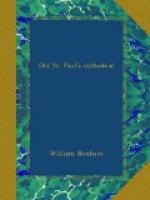on the Continent, affected him so deeply that he was
possessed by the absolute conviction that the wrath
of God was upon the land for the sins of the nation
at large, and especially of the Church, and he began
his work as a preacher against the abuses. His
first assault was upon the Mendicant Friars, whom
he held up, as did his contemporary, Chaucer, to the
scorn of the world. Then he passed on to the luxury
in which some of the prelates were living, and to their
overweening influence in the Councils of State.
Edward III., after a reign of great splendour, had
sunk into dotage. John of Gaunt had been striving
for mastery against the Black Prince, but the latter
was dying, July, 1376, and Gaunt was now supreme.
He hated good William of Wykeham, who had possessed
enormous influence with the old king, and he was bent
generally on curbing the power of the higher clergy.
At this juncture Wyclif was summoned to appear at
St. Paul’s to answer for certain opinions which
he had uttered. It is not clear what these opinions
were, further than that they were mainly against clerical
powers and assumptions; questions of doctrine had
not yet shaped themselves. He appeared before
the tribunal, but not alone. Gaunt stood by his
side. And here, for a while, the position of
parties becomes somewhat complicated. Gaunt was
at this moment very unpopular. The Black Prince
was the favourite hero of the multitude, an unworthy
one indeed, as Dean Kitchin has abundantly shown,
but he had won great victories, and had been handsome
and gracious in manners. He was now at the point
of death, and Gaunt was believed to be aiming at the
succession, to the exclusion of the Black Prince’s
son, and was associated in the popular mind with the
King’s mistress, Alice Ferrers, as taking every
sort of mean and wicked advantage of the old man’s
dotage. Added to this the Londoners were on the
side of their Bishop (Courtenay) in defence, as they
held, of the rights of the City. So on the day
of Wyclif’s appearance the cathedral and streets
surrounding it were crowded, to such an extent indeed
that Wyclif had much trouble in getting through, and
when Gaunt was seen, accompanied by his large body
of retainers, a wild tumult ensued; the mob attacked
Gaunt’s noble mansion, the Savoy Palace, and
had not Courtenay intervened, would have burnt it down.
The Black Prince’s widow was at her palace at
Kennington, with her son, the future Richard II.,
and her great influence was able to pacify the rioters.
Soon came an overwhelming change. The succession of the Black Prince’s son was secured, and then public opinion was directed to the other question, Wyclif’s denunciation of the Papal abuses. Relieved from Gaunt’s partisanship, he sprang at once into unbounded popularity. His learning, his piety of life, were fully recognised, and the Londoners were now on his side. He had preached at the very beginning of the new reign that a great amount of treasure, in the hands of the Pope’s agent,




